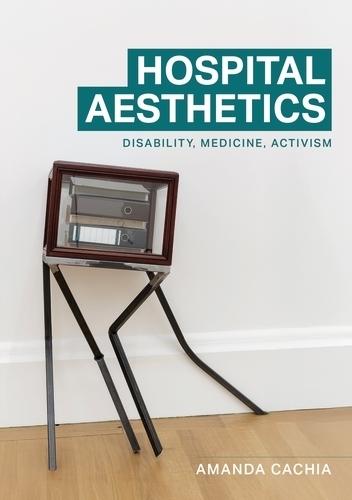Full Product Details
Author: Amanda Cachia
Publisher: Manchester University Press
Imprint: Manchester University Press
Dimensions:
Width: 17.00cm
, Height: 1.50cm
, Length: 24.00cm
Weight: 0.610kg
ISBN: 9781526187888
ISBN 10: 1526187884
Pages: 240
Publication Date: 30 September 2025
Audience:
College/higher education
,
Professional and scholarly
,
General/trade
,
Tertiary & Higher Education
,
Professional & Vocational
Format: Paperback
Publisher's Status: Active
Availability: Not yet available, will be POD

This item is yet to be released. You can pre-order this item and we will dispatch it to you upon it's release. This is a print on demand item which is still yet to be released.
Reviews
‘In Hospital aesthetics, art historian and curator, Amanda Cachia, illuminates connections amongst disability, medicine, and activism, realms of culture seldom considered compatible. This innovative juxtaposition of art and artists shows us that the common, shared human experiences of disability, illness, and care are recorded in the aesthetic archive in elegant and surprising ways.’ —Rosemarie Garland-Thomson, Professor Emerita of English and bioethics, Emory University, Hastings Center Fellow and Senior Advisor on Disability ‘Amanda Cachia builds on her leading role in disability art history with Hospital aesthetics, a field-defining book that brings a deep and scholarly understanding of modern and contemporary art to practices that are considered through the conceptual space of the hospital, a site introduced as a framework for discussions about pain, death, and disability experience, and a critical focus of institutional critique.’ —Lisa Cartwright, Professor of Visual Arts, University of California San Diego ‘In this beautifully written, compelling and extremely original book, Cachia focuses on outstanding artists whose works incorporate experiences of health impairments and long-term hospitalization. Their “rescripting” of medical affordances, she argues, is a powerful form of radical disability activism, decolonizing and transforming both the hospital and the gallery.’ —Faye Ginsburg, David B. Kriser Professor of Anthropology, New York University ‘In Hospital aesthetics: Disability, medicine, activism Amanda Cachia analyzes the work of artists who incorporate experiences with hospitalization and illness while rejecting the medical model of disability. Organized into case studies, the cumulative effect is that of a manifesto for disability activism. Urgent and impassioned, it burns with writing theorized from the body out.’ —Suzanne Hudson, Professor of Art History and Fine Arts, University of Southern California -- .
‘Amanda Cachia builds on her leading role in disability art history with Hospital aesthetics, a field-defining book that brings a deep and scholarly understanding of modern and contemporary art to practices that are considered through the conceptual space of the hospital, a site introduced as a framework for discussions about pain, death, and disability experience, and a critical focus of institutional critique.’ —Lisa Cartwright, Professor of Visual Arts, University of California San Diego ‘In this beautifully written, compelling and extremely original book, Cachia focuses on outstanding artists whose works incorporate experiences of health impairments and long-term hospitalization. Their “rescripting” of medical affordances, she argues, is a powerful form of radical disability activism, decolonizing and transforming both the hospital and the gallery.’ —Faye Ginsburg, David B. Kriser Professor of Anthropology, New York University ‘In Hospital aesthetics: Disability, medicine, activism Amanda Cachia analyzes the work of artists who incorporate experiences with hospitalization and illness while rejecting the medical model of disability. Organized into case studies, the cumulative effect is that of a manifesto for disability activism. Urgent and impassioned, it burns with writing theorized from the body out.’ —Suzanne Hudson, Professor of Art History and Fine Arts, University of Southern California -- .
Author Information
Amanda Cachia is Professor of Practice in Museum Studies in the School of Art at the Herberger Institute for Design and the Arts at Arizona State University. She is a curator, consultant, writer and art historian who specializes in disability art activism.



